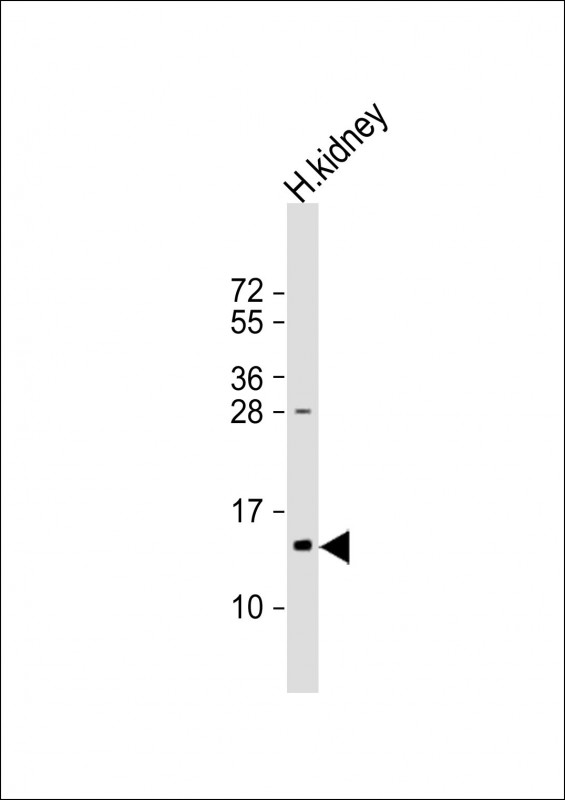TMIE Antibody (Center)
Affinity Purified Rabbit Polyclonal Antibody (Pab)
- SPECIFICATION
- CITATIONS
- PROTOCOLS
- BACKGROUND

Application
| WB, E |
|---|---|
| Primary Accession | Q8NEW7 |
| Other Accession | Q8K467 |
| Reactivity | Human, Mouse |
| Predicted | Mouse |
| Host | Rabbit |
| Clonality | Polyclonal |
| Isotype | Rabbit IgG |
| Calculated MW | 17241 Da |
| Antigen Region | 71-100 aa |
| Gene ID | 259236 |
|---|---|
| Other Names | Transmembrane inner ear expressed protein, TMIE |
| Target/Specificity | This TMIE antibody is generated from rabbits immunized with a KLH conjugated synthetic peptide between 71-100 amino acids from the Central region of human TMIE. |
| Dilution | WB~~1:1000 E~~Use at an assay dependent concentration. |
| Format | Purified polyclonal antibody supplied in PBS with 0.09% (W/V) sodium azide. This antibody is purified through a protein A column, followed by peptide affinity purification. |
| Storage | Maintain refrigerated at 2-8°C for up to 2 weeks. For long term storage store at -20°C in small aliquots to prevent freeze-thaw cycles. |
| Precautions | TMIE Antibody (Center) is for research use only and not for use in diagnostic or therapeutic procedures. |
| Name | TMIE |
|---|---|
| Function | Auxiliary subunit of the mechanotransducer (MET) non-specific cation channel complex located at the tips of stereocilia of cochlear hair cells and that mediates sensory transduction in the auditory system. The MET complex is composed of two dimeric pore-forming ion- conducting transmembrane TMC (TMC1 or TMC2) subunits, and aided by several auxiliary proteins including LHFPL5, TMIE, CIB2/3 and TOMT, and the tip-link PCDH15. May contribute to the formation of the pore. |
| Cellular Location | Membrane; Single-pass type I membrane protein |
| Tissue Location | Expressed in many tissues. |

Thousands of laboratories across the world have published research that depended on the performance of antibodies from Abcepta to advance their research. Check out links to articles that cite our products in major peer-reviewed journals, organized by research category.
info@abcepta.com, and receive a free "I Love Antibodies" mug.
Provided below are standard protocols that you may find useful for product applications.
Background
This gene encodes a transmembrane inner ear protein. Studies in mouse suggest that this gene is required for normal postnatal maturation of sensory hair cells in the cochlea, including correct development of stereocilia bundles. This gene is one of multiple genes responsible for recessive non-syndromic deafness (DFNB), also known as autosomal recessive nonsyndromic hearing loss (ARNSHL), the most common form of congenitally acquired inherited hearing impairment.
References
Yang, J.J., et al. Int. J. Pediatr. Otorhinolaryngol. (2010) In press
Sirmaci, A., et al. Clin. Genet. 75(6):562-567(2009)
Santos, R.L., et al. J. Mol. Med. 84(3):226-231(2006)
Cho, K.I., et al. Comp. Med. 53(6):642-648(2003)
Naz, S., et al. Am. J. Hum. Genet. 71(3):632-636(2002)
Mitchem, K.L., et al. Hum. Mol. Genet. 11(16):1887-1898(2002)
If you have used an Abcepta product and would like to share how it has performed, please click on the "Submit Review" button and provide the requested information. Our staff will examine and post your review and contact you if needed.
If you have any additional inquiries please email technical services at tech@abcepta.com.













 Foundational characteristics of cancer include proliferation, angiogenesis, migration, evasion of apoptosis, and cellular immortality. Find key markers for these cellular processes and antibodies to detect them.
Foundational characteristics of cancer include proliferation, angiogenesis, migration, evasion of apoptosis, and cellular immortality. Find key markers for these cellular processes and antibodies to detect them. The SUMOplot™ Analysis Program predicts and scores sumoylation sites in your protein. SUMOylation is a post-translational modification involved in various cellular processes, such as nuclear-cytosolic transport, transcriptional regulation, apoptosis, protein stability, response to stress, and progression through the cell cycle.
The SUMOplot™ Analysis Program predicts and scores sumoylation sites in your protein. SUMOylation is a post-translational modification involved in various cellular processes, such as nuclear-cytosolic transport, transcriptional regulation, apoptosis, protein stability, response to stress, and progression through the cell cycle. The Autophagy Receptor Motif Plotter predicts and scores autophagy receptor binding sites in your protein. Identifying proteins connected to this pathway is critical to understanding the role of autophagy in physiological as well as pathological processes such as development, differentiation, neurodegenerative diseases, stress, infection, and cancer.
The Autophagy Receptor Motif Plotter predicts and scores autophagy receptor binding sites in your protein. Identifying proteins connected to this pathway is critical to understanding the role of autophagy in physiological as well as pathological processes such as development, differentiation, neurodegenerative diseases, stress, infection, and cancer.



